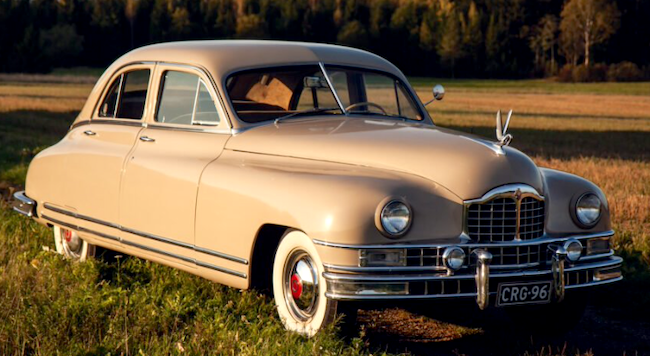Above is a 1948 Packard Custom Eight Touring Sedan for sale in Finland. It was the top-of-the-line sedan (excluding limousines) with a wheelbase of 127 inches (3226 mm). Lesser 1948-1950 Packards had a wheelbase of 120 inches (3048 mm). Both types are shown below.
Packard heavily facelifted its excellent 1941 Clipper design for the 1948 model year in order to present a "postwar" face to the buying public. Noses were rounded, grilles placed lower and restyled, and -- most noticeably, fenders were merged into featureless slab sides. Given that Packards were large cars to begin with, those slab sides made Packards seem ponderous. Nevertheless, they sold well for the first two years until the design looked dated.
Packard stylists and management were aware of the visual bulk design problem, so in the middle of the 1949 model year, Packard introduced a new series.
Rather than designating its models by year, from the 1920s Packard referred to its cars by annual sequential series numbers, not by model years. Some exceptions: There was No 13th Series. And the 21st Series covered both the 1946 and 1947 model years. This difference between series number and model year ended in the 1950s when series numbers coincided with model year designations. During the 1948-1950 period dealt with in this post, the series business became a bit complicated. The 22nd Series (1948 model year) was extended well into the 1949 model year. Then the 23rd Series was announced, and it continued through the 1950 model year. In the discussions in the Gallery below, 1948 Packards are labeled as such, but are understood to be 22nd Series cars. And 1950 models are understood to be of the 23rd Series. For 1949, series numbers are made explicit.
We are dealing with a 23rd Series feature added to 22nd Series models. An inexpensive means of reducing the visual bulk of those slab-sided 22nd Series Packards was the application of a bold, horizontal chrome strip a bit above the midpoint of the fenders. It was effective, though the ultimate cure was a redesigned set of bodies for model year 1951.
1948 Packard Eight DeLuxe Touring Sedan - car-for-sale photo
The short-wheelbase four-door Packard sedan. Being shorter, it didn't look quite so bulky as the longer cars. Not a good design, regardless.
1950 Packard Eight Deluxe Touring Sedan - photo via Hemmings
In all cases, the new chrome strips were place atop the front wheel openings and touched the redesigned tail alight assembles at the rear. These unifying visual anchors helped to establish the desired increased visual length.
1949 22nd Series Packard Eight DeLuxe Club Sedan - Mecum Auctions photo
Two-door Club Sedans had a more racy appearance due to their fastback profile. Working against that was the heaviness due to large sheet-metal areas on those passenger compartment greenhouses -- something added fender chrome strips could not alter.
1949 23rd Series Packard Eight Club Sedan - car-for-sale photo
That said, the chrome strip was helpful on Club Sedans.
1948 Packard Custom Eight Touring Sedan - Mecum
Long-wheelbase 4-door Packard. 22nd Series Custom Eights had two thin chrome strips low on the sides, but these did little to reduce the visual bulk.
1950 Packard Super Deluxe Touring Sedan - car-for-sale photo
23rd Series Custom Eight Packards retained those lower strips along with the new mid-level strip. The Super Deluxe range shown here was given the 127-inch wheelbase for the 23rd Series, so this car is equivalent to the one in the previous image. Again, the new chrome strip is helpful. Note that the front of the strip includes that famous Packard pen-nib detail, a touch that was abandoned on 22rd Series cars.
1948 Packard Custom Eight Convertible Victoria - RM Auctions photo
Convertibles are intrinsically more racy than similar models with structured passenger compartment greenhouses. For that reason, 22nd Series Packard convertibles didn't seem so bulky as sedans and have remained popular with car collectors.
1950 Packard Super Deluxe Convertible Victoria - BaT Auctions photo
As usual, the chrome strip enhances appearance.









6 comments:
some wags called these "pregnant elephants"
Yes, the higher chrome line makes a bigger difference than you might think. They made a lot of other modifications front and back, and enlarged the back window.
In the movie Carol the star car was a 1948 Packard Custom Eight Victoria. They made tons of mistakes with other cars (not the years) in that film though.
When I was a kid the parish priest had a four door example of what I now know was earlier version. Of course I didn't know it was a facelifted prewar fenders and body design, but I did think it was quite the blimp of a car and wondered why anyone would choose one. And really before power steering, even with those ship sized steering wheels I don't understand why anyone would want to drive anything bigger than the smallest, lightest car available.
On all these Packards, that giant bird ornament seems like quite an anachronism. They folded its wings in 1952.
a buddy had 1950 Packard Eight. It did not have the cormorant (?) ornament, but a stylized flying wheel
Dee Exx and emjayay -- I should have noted that auction cars and cars for sale (and others pictured on the Web) often have the cormorant hood ornament incorrectly 'cause, I suppose, it looks classier than the thingy that came standard on lesser Packards. So some owners replaced the original with the cormorant. The bird was standard on the more expensive models.
I was wondering about the bird being put on later models by owners like with the Jaguar leaper, so I did a quick check at oldcarbrochures.
All postwar car dealers were eager to sell as many accessories as possible, and hood ornaments were pretty easily upgraded.
Post a Comment